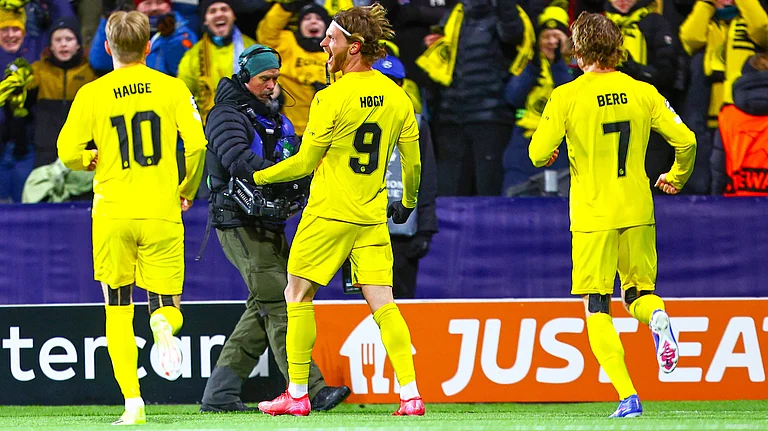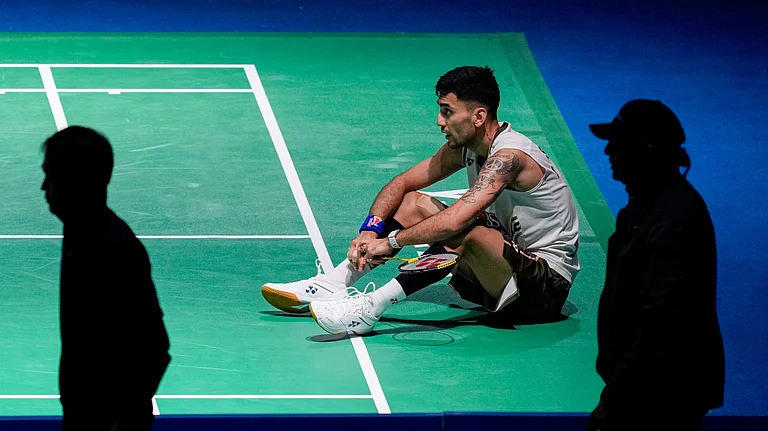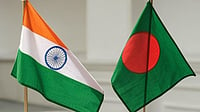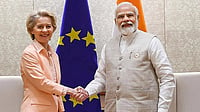On Wednesday, farmers from Amritsar's Bhakna and nearby villages were asked to vacate their farms and move indoors as police rained bullets at a house where the alleged killers of Sidhu Moosewala were hiding. Gangsters Jagroop Singh Roopa and Manpreet Singh alias Mannu Kusa were killed by the Punjab Police in Amritsar in an encounter that went on for around five hours on Wednesday.
The area was cordoned off during the operation and people were asked to stay indoors. Police personnel wearing bulletproof jackets were seen taking cover behind a tractor and a trolley near the building where the gangsters were hiding. Two armoured vehicles and some bulletproof vehicles were also deployed during the operation. Singer Shubhdeep Singh Sidhu, popularly known as Sidhu Moosewala, was shot dead in Punjab's Mansa district on May 29.
While Punjab police celebrated the encounter of the alleged killers, the killing has led to sharp reactions from Opposition party Congress in Punjab with state chief Amrinder Singh Raja Warring claiming that the police encounter was no consolation for the family and millions as it would not bring Moosewala back.
“This can neither bring Moosewala back, nor can it wash off the stain on the Punjab government, whose criminal lapse and negligence in the pruning of his security led to his killing,” Warring said in a statement, adding that several serious questions about the grave lapse on part of the government in not providing the singer security despite a threat to his life remained unanswered. “Ideally the shooters should have been nabbed alive to get to the bottom of the conspiracy behind Moosewala's murder,” he said.
This, however, is not the first time that police in India have been involved in encounter killings of gangsters. In fact, extrajudicial killings have been a controversial topic in India in the last few decades and police in several states have time and again come under the lens for alleged abuse of power.
Extrajudicial killings in India
Extrajudicial killings or custodial killings refer to the instances of death or prosecution of a criminal, accused, undertrial or detainee before his legal and fair sentencing in a court of law. In a modern democracy based on the 'Rule of Law' (equality of law for all) like India, extrajudicial killings are often seen as a failure of the law and order enforcement machinery as well as the judiciary and legislature that are together entrusted with ensuring the sanctity of the constitutional rights of each citizen, including convicts and criminals.
In India, 164 people were killed in police encounters in 2018-19, as per the National Human Rights Commission. The number was 188 in 2014-15. The NHRC has recommended action against police personnel in 25 cases for alleged human rights violations and fake encounter deaths. None of the personnel have yet been prosecuted.
Following the murder of Sidhu Moosewala, rumors of police encounters have been rife in Punjab with several local reports touting that gangster Lawrence Bishnoi, suspected in Moosewala's killing, living in fear of being encountered by the police. In Punjab itself, police encounter of wanted gangsters has not been uncommon. In June 2021, known Punjab gangster Jai Pal Singh Bhullar was killed in an alleged police encounter in Kolkata. Bhullar's father accused the son of torturing and killing his son and returning his body under the guise of an encounter. In January 2018, Punjab Police had killed another most wanted gangster Vicky Gounder and his aide Prema Lahoria in an encounter. But while the police and law enforcement agencies are legally empowered to attack individuals in self defense or to prevent them from causing harm, the legality of encounter killings and questions over "fake" or "staged" encounters have often led to scrutiny in the country.
What the law says
In India, police forces have the right to injure or kill criminals or accused, but only for self-defense or when it is imminently necessary for the maintenance of peace and order. This right is enshrined in Section 96 of the Indian Penal Code (IPC) which gives every human being the right to private defense as a natural and inherent right.
Under Section 46 of the Indian Criminal Procedure Code, police officials can use "all means necessary" to arrest a criminal detainee or to control the situation. Such force can result in death. In areas where the Armed Forces (Special Powers) Act (AFSPA), are prevalent, the Indian Defense Forces have wide-ranging powers to act against suspects.
In the last few years, Section 376 was amended under the Criminal Law Amendment Act, 2013 to emphasize the prevention of custodial abuses and deaths. Another important amendment is the insertion of Section 114(A), in the Indian Evidence Act, 1872. Recently, a court in India doubled down on police officers accused of killing four rape-murder accused in a fake encounter. And yet, extrajudicial killings have continued in India over the last few decades. One of the most controversial instances of extrajudicial killings is the Hashimpura encounters in 1987 when 42 Muslim men were rounded up by police in Uttar Pradesh and killed.
In Punjab, the police have stated that the encounter of the alleged killers of Moosewala was an act of self-defense . Videos showed firing from both sides as the police tried to nab the two accused. In the past, however, police encounters of gangsters has led to political and legal repercussions as well.
Here are some of the instances of extrajudicial killings in India in the last two decades that have led to inquiries and in some cases, convictions against police officers and personnel who killed in the name of duty:
Vikas Dubey encounter
In one of the most recent instances of gangster encounters in India, infamous gangster Vikas Dubey who was allegedly responsible for the death of eight police personnel was killed in an encounter in July 2020 after a police vehicle carrying him from Ujjain to Kanpur met with an accident and he tried to escape from the spot. The encounter, which had multiple dubious aspects, led to various questions regarding the legality of the killing. Before the encounter, five members of Dubey's gang were killed in separate encounters. Previously, eight policemen, including DSP Devendra Mishra, were ambushed in Bikru village of Kanpur when they were going to arrest Dubey and fell to bullets fired from rooftops shortly after midnight on July 3. The encounter raised questions due to reports of an alleged nexus between Dubey and the police.
Hyderabad encounter of alleged rapists
Another extrajudicial killing of alleged rapists in the 2019 Hyderabad veterinarian gangrape case led to a debate across the country after the police opened fire on the four accused of raping and killing the victim and burning the body on November 27. After their arrest, the accused were taken to the location of the crime to recover certain belongings of the victim. As per the police, the accused tried to escape by snatching the personnel's firearms and attacking the cops after which police opened retaliatory fire, killing all four accused. Critics noted that the circumstances leading up to the encounter were questionable and that the killing occurred amid intense pressure of the state government seeking justice for the victim and punishment for the heinous crime. Despite the criticism over the extrajudicial killings, large sections of the country celebrated the killing. The kin of the accused have alleged that the encounter was fake and have demanded action against the allegedly unlawful actions of the cops involved in the encounter. On May 21, 2022, a Supreme Court-mandated three-member panel led by Justice V.S. Sirpurkar recommended charging all 10 police personnel accused with the murder of the four accused in the ‘fake encounter’.
Bhopal Jail encounter
In 2016, eight members of the Students’ Islamic Movement of India (SIMI) were killed by Madhya Pradesh police after they allegedly escaped from Bhopal Central Jail. According to the police, the escapees were killed when they opened fire on the cops but several viral videos at the time suggested that the encounter may have been fake. In 2018, the police was given a clean chit by a one-person judicial commission chaired by retired Madhya Pradesh High Court judge S.K. Pandey.
'Lakhan Bhaiya' encounter
21 persons, including 13 policemen, were sentenced to life imprisonment by a sessions court in 2013 in connection with the 2006 fake encounter killing of Ram Narayan Gupta alias Lakhan Bhaiya, an alleged aide of fugitive gangster Chhota Rajan. Former encounter specialist Pradeep Sharma, who is credited with gunning down over 100 criminals, was acquitted at the same time. Gupta had been killed in a staged encounter by Mumbai Police in 2006.
Veerappan encounter
Notorious gangster and dacoit Veerappan, who along with his gang was accused of multiple kidnappings, smuggling, and wildlife poaching incidents, was killed by the Tamil Nadu Special Task Force in October 2004 during an encounter that has since become part of pop culture. According to reports, the gangster who had managed to give the police a run for nearly a decade was finally caught after authorities tricked him into entering an ambulance in which he needed to go see a doctor for his eye. As per reports, the task force personnel fired 338 bullets at the vehicle, out of which only three allegedly hit the gangster. However, questions about a suspected 'cover-up' were raised after Veerappan was found to have bullet holes only in his head and eye but nowhere else in his body.
Batla House encounter
The Batla House encounter is perhaps the most infamous incident of extrajudicial killing in the country when Delhi Police shot dead two suspected members of the terrorist organization Indian Mujahideen in the crowded Jamia Nagar area of the capital in 2008. Inspector Mohan Chand Sharma, of the police's special cell, known as an "encounter specialist" who was leading the operation, was also killed in the shootout following serial bomb blasts in the national capital in which 39 people died and 159 were injured. The operation, which was meant to conduct questioning among Jamia Nagar residents, escalated into a 20-minute shootout whose legality has since been questioned by critics. In 2021, a Delhi court awarded the death penalty to Ariz Khan for the murder of Sharma, saying the offence fell under the "rarest of the rare category" warranting the maximum sentence. Ariz Khan had fled from the spot and was declared a proclaimed offender. He was arrested on February 14, 2018, after a decade-long run and faced trial. Indian Mujahideen terrorist and co-accused Shahzad Ahmed was awarded life imprisonment in 2013 in connection with the case. His appeal against the verdict has been pending in the high court.
Ishrat Jahan, Sadiq Jamal
The infamous encounters of Sadiq Jamal and Ishrat Jahan, both by Gujarat Police in 2003 and 2004 respectively, remain controversial question marks on the state police's record. Both were killed after being suspected in alleged plans to kill then Gujarat Chief Minister Narendra Modi. 19-year-old Mumbai student Jahan was killed in 2004 along with three others after being accused of being a Lashkar-e-Taiba (LeT) operative involved in a plot to assassinate Modi. Later court initiated investigations showed that the encounter might have been staged. In March 2021, A special Central Bureau of Investigation (CBI) court in Ahmedabad discharged three police officers accused in the alleged fake encounter case. In its first 2013 charge sheet, however, the CBI had named seven police officers. Two of the officers were forced to resign from their posts following Supreme Court's orders. In 2017, a former terrorist James Hadley told the media that Jahan had been a LeT operative.
In a similar case a year before Jahan's killing, Gujarat Police had gunned down Sadiq Jamal in 2004 who was suspected in a similar plot to kill Modi. CBI investigations later showed that the encounter may have been staged and that not only Gujarat Police but the Intelligence Bureau (IB) was also involved in the matter. Jamal's father has since moved court and sought Rs 50 lakh compensation for his son's killing. The genuineness of the encounter became an issue after former Mumbai-based scribe Ketan Tirodkar filed an affidavit before a court in Mumbai that he was witness to Jamal's hand-over to Gujarat police by the 'encounter specialist' officer Daya Nayak of Mumbai police, a few days before the encounter.
Sohrabuddin Sheikh, Tulsiram Prajapati
In 2006, Gujarat Police Anti Terror Squad (ATS) ambushed Sohrabuddin Sheikh - a suspected extortionist and gangster making money off the marble trade in Gujarat and Rajasthan. Sheikh had been traveling with his wife Kausar Bi when they were allegedly nabbed and taken to an undisclosed location. Three days later, Sheikh was taken away by some officers and killed allegedly by a joint team comprising Gujarat and Rajasthan police on November 26. Sheikh's wife Kausar Bi was also allegedly killed a few days later and her body was burnt and disposed of. Sheikh's aide Tulsiram Prajapati, who had been arrested and was in a separate jail, was also encountered a few days after Sheikh's killing. As per reports, Prajapati had been with Sheikh at the time he and his wife were apprehended. Police claimed Prajapati was caught in Rajasthan and later encountered. The 22 accused in the alleged fake encounter case of Sohrabuddin Sheikh, his wife Kausar Bi, and associate Tulsi Prajapati, were acquitted by a special CBI court in Mumbai on December 21, 2018 after the court observed that the prosecution failed to establish charges against them.
(With inputs from PTI)


























